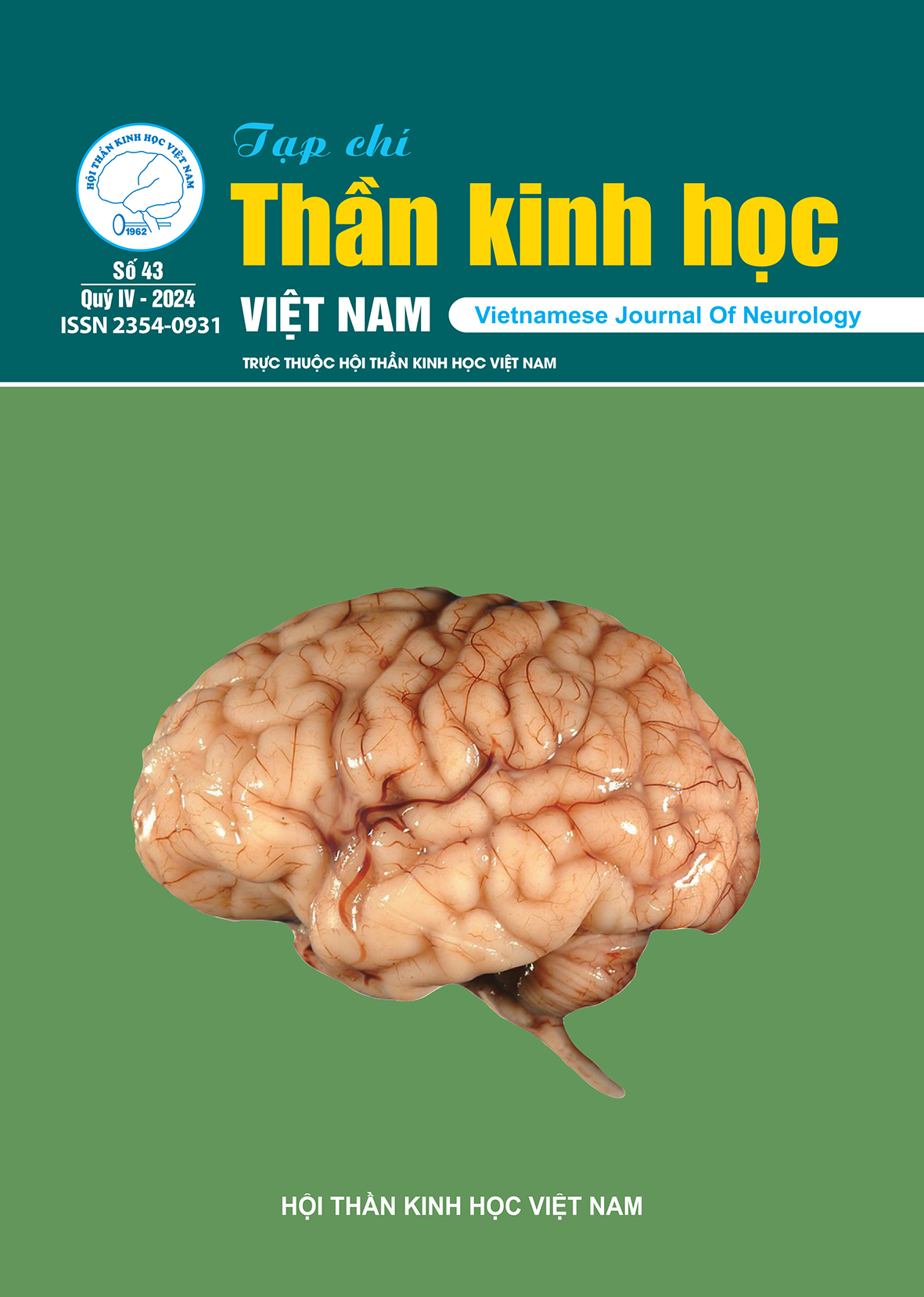Viêm tĩnh mạch tại vị trí lưu kim luồn tĩnh mạch ngoại biên và một số yếu tố liên quan tại Trung tâm Thần kinh, Bệnh viện Bạch Mai

DOI:
https://doi.org/10.62511/vjn.43.2024.037Từ khóa:
Phlebitis Peripheral Venous Catheter (PVC) Neurology Center Bach Mai HospitalLượt tải xuống
Đã xuất bản
Số tạp chí
Chuyên mục
Thể loại
Cách trích dẫn
Tóm tắt
Đặt vấn đề: Viêm tĩnh mạch tại vị trí lưu kim luồn tĩnh mạch ngoại biên (Peripheral Venous Catheter - PVC) là một biến chứng phổ biến trong các cơ sở y tế, gây ra đau đớn, gián đoạn điều trị và có khả năng dẫn đến các biến chứng nghiêm trọng.
Mục tiêu: Bài báo này nhằm mục đích khảo sát tỷ lệ viêm tĩnh mạch và các yếu tố nguy cơ liên quan đến viêm tĩnh mạch tại vị trí lưu kim luồn tĩnh mạch ngoại biên (KLTMNB) trên người bệnh.
Phương pháp nghiên cứu: Phương pháp nghiên cứu mô tả cắt ngang, sử dụng bộ câu hỏi tự tạo, lấy sẵn thang điểm VIP (Visual Infision Phlebitis Scale) về mức độ viêm tĩnh mạch, được tiến hành trên 347 bệnh nhân điều trị nội trú có đặt kim luồn tĩnh mạch ngoại biên tại phòng Cấp cứu và Hồi sức tích cực, Trung tâm Thần kinh, bệnh viện Bạch Mai. Dữ liệu được thu thập từ hồ sơ bệnh án và quan sát lâm sàng.
Kết quả: Trong số các bệnh nhân được nghiên cứu, tỷ lệ người bệnh xuất hiện viêm tĩnh mạch tại vị trí lưu KLTMNB là 17.6%; 4.3% vị trí đặt kim truyền có xuất hiện tình trạng viêm. Mức độ viêm phổ biến là độ 1 (43.1%) và độ 2 (54.2%), một số ít có viêm độ 3(2.8%), không có viêm độ 4, độ 5.
Những yếu tố như vị trí đặt kim ở cẳng tay, khuỷu tay hay cổ chân; các bệnh lý như tăng huyết áp, chảy máu não, viêm phổi; tình trạng liệt các chi; truyền dịch liên tục và một số loại thuốc duy trì đường tĩnh mạch được xác định là có liên quan đến nguy cơ viêm tĩnh mạch.
Kết luận: Viêm tĩnh mạch tại vị trí lưu KLTMNB là một vấn đề cần được chú ý trong quá trình điều trị. Việc lựa chọn vị trí đặt kim hợp lý, cùng với quản lý tốt các bệnh lý nền, có thể giúp giảm thiểu nguy cơ viêm tĩnh mạch. Những kết quả này có thể hỗ trợ trong việc đưa ra các hướng dẫn lâm sàng để nâng cao chất lượng chăm sóc bệnh nhân.
Tài liệu tham khảo
Carr PJ, Higgins NS, Cooke ML, Mihala G, Rickard CM. Vascular access specialist teams for device insertion and prevention of failure. Cochrane Database Syst Rev. Mar 20 2018;3(3):Cd011429. doi:10.1002/14651858.CD011429.pub2
DOI: https://doi.org/10.26226/morressier.5af985f5101067001b3aaa9b

Zingg W, Pittet D. Peripheral venous catheters: an under-evaluated problem. Int J Antimicrob Agents. 2009;34 Suppl 4:S38-42. doi:10.1016/s0924-8579(09)70565-5
DOI: https://doi.org/10.1016/S0924-8579(09)70565-5

Takahashi T, Murayama R, Abe-Doi M, et al. Preventing peripheral intravenous catheter failure by reducing mechanical irritation. Scientific Reports. 2020/01/31 2020;10(1):1550. doi:10.1038/s41598-019-56873-2
DOI: https://doi.org/10.1038/s41598-019-56873-2

Blanco-Mavillard I, Rodríguez-Calero MÁ, de Pedro-Gómez J, Parra-García G, Fernández-Fernández I, Castro-Sánchez E. Incidence of peripheral intravenous catheter failure among inpatients: variability between microbiological data and clinical signs and symptoms. Antimicrobial Resistance & Infection Control. 2019/07/22 2019;8(1):124. doi:10.1186/s13756-019-0581-8
DOI: https://doi.org/10.1186/s13756-019-0581-8

Park HJ, Kim KH, Lee HJ, Jeong EC, Kim KW, Suh DI. Compartment syndrome due to extravasation of peripheral parenteral nutrition: extravasation injury of parenteral nutrition. Korean journal of pediatrics. Nov 2015;58(11):454-8. doi:10.3345/kjp.2015.58.11.454
DOI: https://doi.org/10.3345/kjp.2015.58.11.454

Sacks GS, Mir TL, Lee M. Skin necrosis induced by extravasation of glycerol-containing peripheral parenteral nutrition formulation. Journal of the Mississippi State Medical Association. Sep 1999;40(9):307-11.

Kahn JM, Kress JP, Hall JB. Skin necrosis after extravasation of low-dose vasopressin administered for septic shock. Critical care medicine. Aug 2002;30(8):1899-901. doi:10.1097/00003246-200208000-00038
DOI: https://doi.org/10.1097/00003246-200208000-00038

Helm RE, Klausner JD, Klemperer JD, Flint LM, Huang E. Accepted but unacceptable: peripheral IV catheter failure. Journal of infusion nursing : the official publication of the Infusion Nurses Society. May-Jun 2015;38(3):189-203. doi:10.1097/nan.0000000000000100
DOI: https://doi.org/10.1097/NAN.0000000000000100

Digiovine B, Chenoweth C, Watts C, Higgins M. The attributable mortality and costs of primary nosocomial bloodstream infections in the intensive care unit. American journal of respiratory and critical care medicine. Sep 1999;160(3):976-81. doi:10.1164/ajrccm.160.3.9808145
DOI: https://doi.org/10.1164/ajrccm.160.3.9808145

Jarvis WR. Selected aspects of the socioeconomic impact of nosocomial infections: morbidity, mortality, cost, and prevention. Infection control and hospital epidemiology. Aug 1996;17(8):552-7. doi:10.1086/647371
DOI: https://doi.org/10.2307/30141291

Ray-Barruel G, Polit DF, Murfield JE, Rickard CM. Infusion phlebitis assessment measures: a systematic review. Journal of evaluation in clinical practice. Apr 2014;20(2):191-202. doi:10.1111/jep.12107
DOI: https://doi.org/10.1111/jep.12107

Nhung LT, Trung TQ, Cúc LT. Viêm tĩnh mạch tại vị trí lưu kim luồn tĩnh mạch ngoại biên và một số yếu tố liên quan tại Bệnh viện Đại học Y Hà Nội. Tạp chí Nghiên cứu Y học. 10/30 2021;145(9):85-92. doi:10.52852/tcncyh.v145i9.272
DOI: https://doi.org/10.52852/tcncyh.v145i9.272

Long CV, He, D.V. Nghiên cứu nguy cơ viêm tĩnh mạch sau đặt catheter tĩnh mạch ngoại vi tại Bệnh viện hữu nghị Việt Đức. Tạp chí Khoa học điều dưỡng. 2020;4(4)

Duy Q. Đánh giá tình trạng viêm tại chỗ trên người bệnh có đặt catheter tĩnh mạch ngoại biên tại Bệnh viện Trung ương Huế. Journal of Clinical Medicine- Hue Central Hospital. 07/01 2020;doi:10.38103/jcmhch.2020.63.10
DOI: https://doi.org/10.38103/jcmhch.2020.63.10

QuỳnhV. B. TN, YếnP. K., LongB. H., NgọcL. M., ChungT. Đức, & AnT. T. T. Khảo sát tỷ lệ viêm tại chỗ và một số yếu tố liên quan sau đặt catheter tĩnh mạch ngoại vi tại Bệnh viện Trung ương Quân đội 108 năm 2021. Journal of 108 - Clinical Medicine and Phamarcy. 2022;17(DB8)
DOI: https://doi.org/10.52389/ydls.v17iDB8.1309

Lanbeck P, Odenholt I, Paulsen O. Perception of risk factors for infusion phlebitis among Swedish nurses: a questionnaire study. J Infus Nurs. Jan-Feb 2004;27(1):25-30. doi:10.1097/00129804-200401000-00004
DOI: https://doi.org/10.1097/00129804-200401000-00004

Lisa Gorski LH, Mary E. Hagle, Mary McGoldrick, Marsha Orr, Darcy Doellman, . Infusion Therapy Standards of Practice Journal of Infusion Nursing. 2016;39(1)

Cicolini G, Manzoli L, Simonetti V, et al. Phlebitis risk varies by peripheral venous catheter site and increases after 96 hours: a large multi-centre prospective study. J Adv Nurs. Nov 2014;70(11):2539-49. doi:10.1111/jan.12403
DOI: https://doi.org/10.1111/jan.12403

Yasuda H, Yamamoto R, Hayashi Y, et al. Occurrence and incidence rate of peripheral intravascular catheter-related phlebitis and complications in critically ill patients: a prospective cohort study (AMOR-VENUS study). J Intensive Care. Jan 6 2021;9(1):3. doi:10.1186/s40560-020-00518-4
DOI: https://doi.org/10.1186/s40560-020-00518-4

C.V L, D.V H. Nghiên cứu nguy cơ viêm tĩnh mạch sau đặt catheter tĩnh mạch ngoại vi tại Bệnh viện hữu nghị Việt Đức. Tạp chí Khoa học điều dưỡng. 2020;4(4):33-42.

Kawada K, Ohta T, Tanaka K, Kadoguchi N, Yamamoto S, Morimoto M. Risk Factors of Nicardipine-Related Phlebitis in Acute Stroke Patients. J Stroke Cerebrovasc Dis. Oct 2016;25(10):2513-8. doi:10.1016/j.jstrokecerebrovasdis.2016.06.028
DOI: https://doi.org/10.1016/j.jstrokecerebrovasdis.2016.06.028

Lanbeck P, Odenholt I, Paulsen O. Antibiotics differ in their tendency to cause infusion phlebitis: a prospective observational study. Scand J Infect Dis. 2002;34(7):512-9. doi:10.1080/00365540110080908
DOI: https://doi.org/10.1080/00365540110080908










